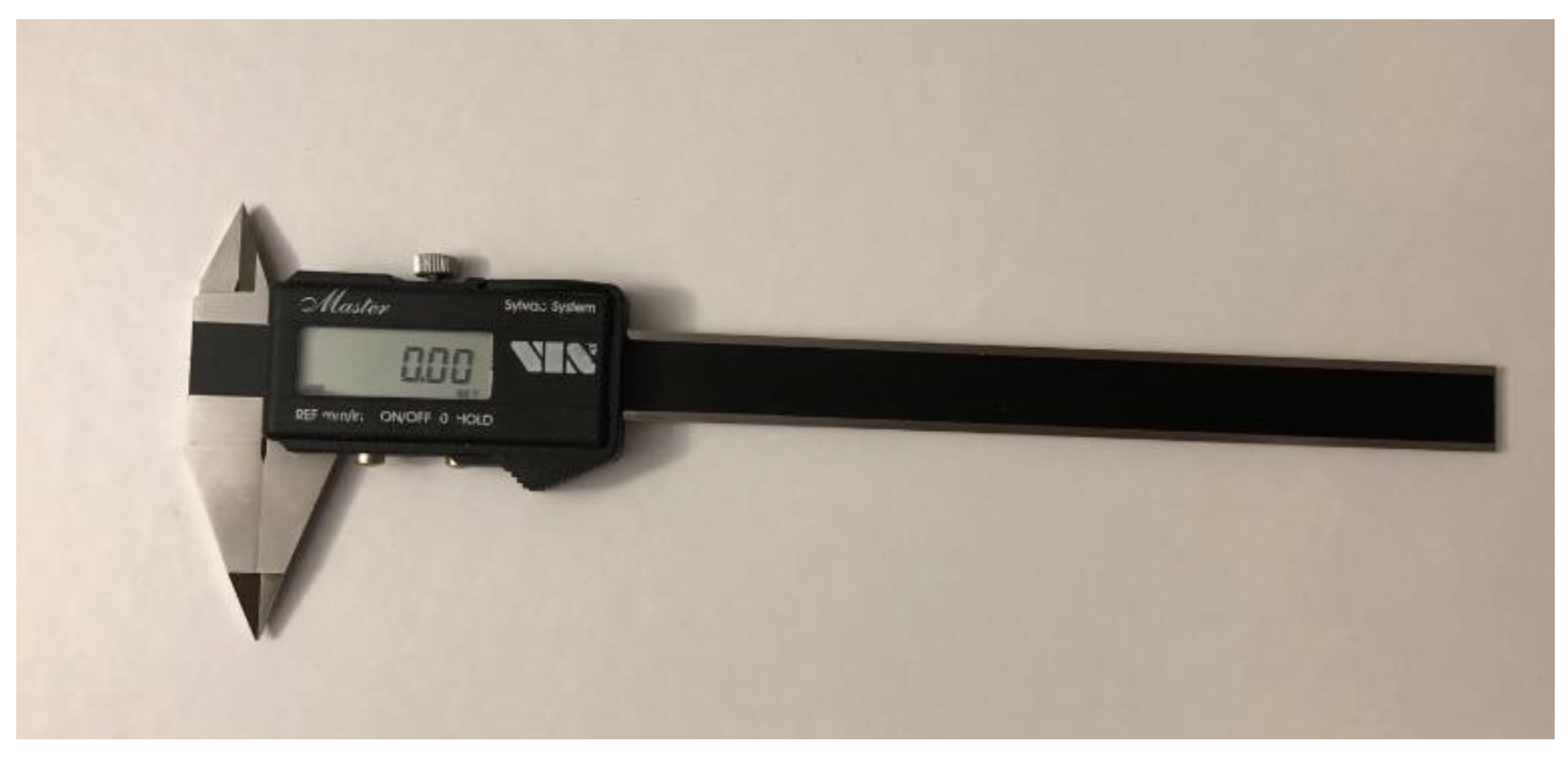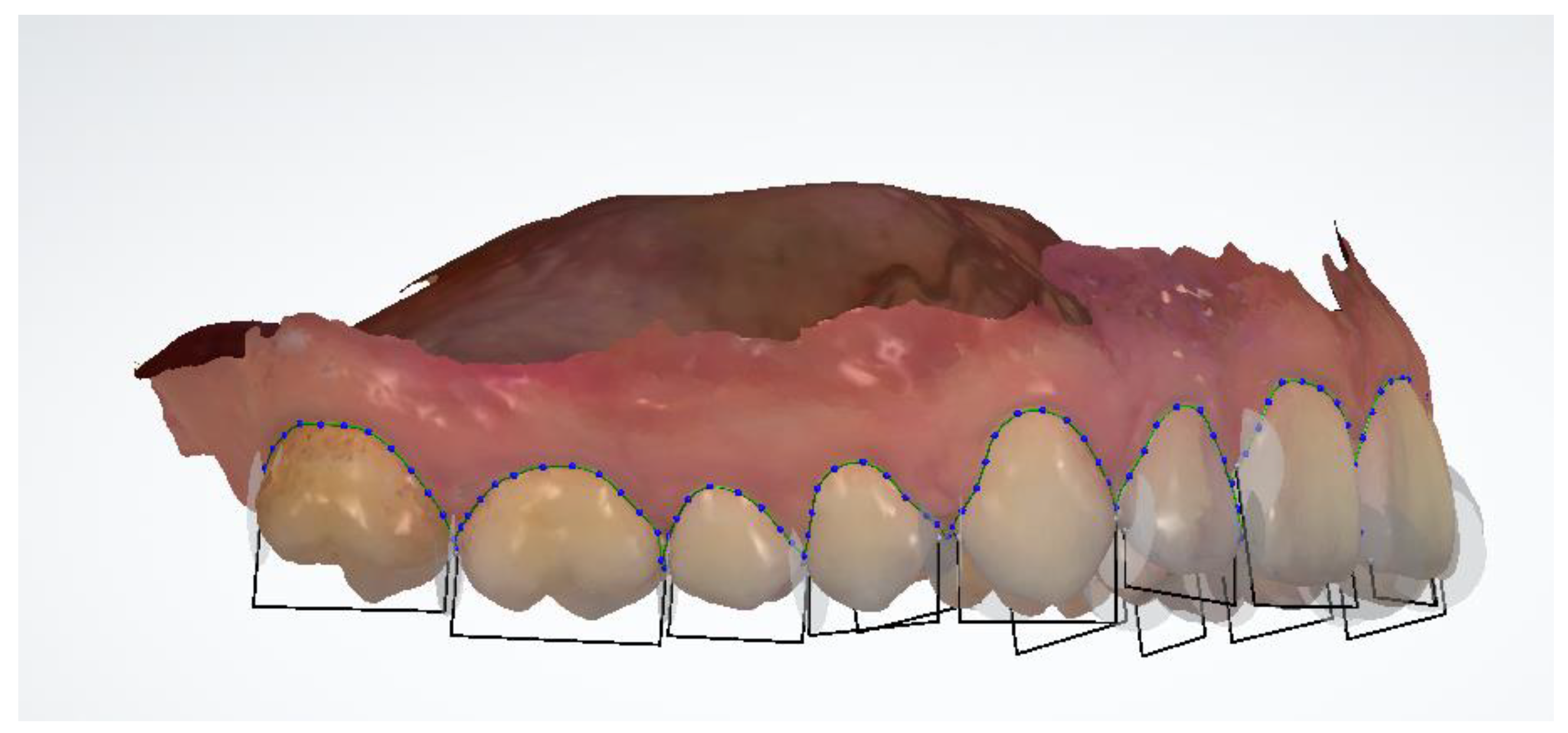A Comparison of Teeth Measurements on Plaster and Digital Models
Abstract
1. Introduction
Purpose of Research
2. Materials and Methods
3. Results
4. Discussion
5. Conclusions
Author Contributions
Funding
Institutional Review Board Statement
Informed Consent Statement
Data Availability Statement
Conflicts of Interest
References
- Rożyło-Kalinowska, I.; Rożyło, T. Contemporary Dental Radiology; Cheer: Lublin, Poland, 2015. [Google Scholar]
- Plooij, J.; Maal, T.; Haers, P.; Borstlap, W.; Kuijpers-Jagtman, A.; Berge, S. Digital three-dimensional image fusion processes form planning and evaluating orthodontics and orthognathic surgery. A systematic review. Int. J. Oral. Maxillofac. Surg. 2001, 40, 341–352. [Google Scholar]
- Mavili, M.; Canter, H.; Saglam- Aydinatay, B.; Kamaci, S.; Kocadereli, I. Use of three-dimensional medical modeling methods for precise planning of orthognathic surgery. J. Craniofac. Surg. 2007, 18, 740–747. [Google Scholar] [CrossRef] [PubMed]
- Premkumar, S. Textbook of Orthodontics; Elselvier: Amsterdam, The Netherlands, 2015; pp. 365–367. [Google Scholar]
- Jedlinska, A. Th ecomparison analysis of the line measurements between plaster and virtual orthodontic 3d models. Ann. Acad. Med. Stetin. 2008, 54, 106–113. [Google Scholar] [PubMed]
- Truszkowski, M. Three-dimensional imaging in orthodontics. Orthop. Lucky Orthod. 2002, 4, 19–21. [Google Scholar]
- Jaworski, S. 3D Modeling and Reverse Engineering Technology in Orthodontic Diagnostics. Bachelor’s Thesis, University of Technology Wroclawska, Wrocław, Poland, 2004; pp. 31–35. [Google Scholar]
- Patzelt, S.; Bishti, S.; Stampf, S.; Att, W. Accuracy of computer-aided design/computer-aide manufacturing-generated dental casts based on intraoral scanner data. J. Am. Dent. Asso. 2014, 145, 1133–1140. [Google Scholar] [CrossRef] [PubMed]
- Logozzo, S.; Zanetti, E.; Franceschini, G.; Kilpela, A.; Makynen, A. Recent advances in dental optics-Part I: 3D intraoral scanners for restorative dentistry. Opt. Lasers Eng. 2014, 54, 203–221. [Google Scholar] [CrossRef]
- Kravitz, N.; Groth, C.; Jones, P.; Graham, J.; Redmond, W. Intraoral digital scanners. J. Clin. Orthod. 2014, 48, 337–347. [Google Scholar] [PubMed]
- Motohashi, N.; Kuroda, T. A 3D computer-aided design system applied to diagnosis and treatment planning in orthodontics and orthognathic surgery. Eur. J. Orthod. 1999, 21, 263–274. [Google Scholar] [CrossRef] [PubMed]
- Zilberman, O.; Huggare, J.; Parikakis, K. Evaluation of the validity of tooth size and arch width measurments using conventional and three- dimentional virtual orthodontic models. Angle Orthod. 2003, 73, 301–306. [Google Scholar] [PubMed]
- Fleming, P.; Marinho, V.; Johal, A. Orthodontic measurements on digital study models compared with plaster models: A systematic review. Orthhod. Craniofac. Res. 2011, 14, 1–16. [Google Scholar] [CrossRef]
- Rossini, G.; Parrini, S.; Castroflorio, T.; Deregibus, A.; Debernardi, C. Diagnostic accuracy and measurment sensitivity of digital models for orthodontic purposes: A systematic review. Am. J. Orthod. Dentofac. Orthop. 2016, 149, 161–170. [Google Scholar] [CrossRef] [PubMed]
- Mullen, S.; Martin, C.; Ngan, P.; Gladwin, M. Accuracy of space analysis with emodels and plaster models. Am. J. Orthod. Dentofac. Orthop. 2007, 132, 346–352. [Google Scholar] [CrossRef]
- Watanabe-Kanno, G.; Abrao, J.; Miasiro Junior, H.; Sanchez-Ayala, A.; Lagravere, M. Reproducibility, reliability and validity of measurements obtained from Cecile3 digital models. Braz. Oral Res. 2009, 23, 288–295. [Google Scholar] [CrossRef]
- Leifert, M.; Leifert, M.; Efstratiadis, S.; Cangialosi, T. Comparison of space analysis evaluations with digital models and plaster dental casts. Am. J. Orthod. Dentofacial. Orthop. 2009, 136, 16. [Google Scholar] [CrossRef] [PubMed]
- Asquith, J.; Gillgrass, T.; Mossey, P. Three-dimensional imaging of orthodontic models: A pilot study. Eur. J. Orthod. 2007, 29, 517–522. [Google Scholar] [CrossRef] [PubMed]
- Aly, P.; Mohsen, C. Comparison of the accuracy of three- dimencional printed casts, digital casts, and conventional casts: An in vitro study. Eur. J. Dent. 2020, 14, 189–193. [Google Scholar]
- Hunter, W.; Priest, W. Errors and discrepancies in measurement of tooth size. J. Dent. Res. 1960, 39, 405–414. [Google Scholar] [CrossRef] [PubMed]
- Santoro, M.; Galkin, S.; Teredesai, M.; Nicolay, O.; Cangialosi, T. Comparison of measurements made on digital and plaster models. Am. J. Orthod. Dentofac. Orthop. 2003, 124, 101–105. [Google Scholar] [CrossRef] [PubMed]
- Cuperes, A.; Harms, M.; Rangel, F.; Bronkhorst, E.; Schols, J.; Breuning, K. Dental models made with an intraoral scanner: A validation study. Am. J. Orthod. Dentofac. Orthop. 2012, 142, 308–313. [Google Scholar] [CrossRef] [PubMed]
- Coleman, R.; Hembree, J.; Weber, F. Dimensional stability ofi rreversible hydrocolloid impression material. Am. J. Orthod. 1979, 75, 438–446. [Google Scholar] [CrossRef] [PubMed]
- Alcan, T.; Ceylanoglu, C.; Baysal, B. The relationship between digital model accuracy and time-dependent deformation of alginate impressions. Angle Orthod 2009, 79, 30–36. [Google Scholar] [CrossRef]
- Asquith, J.; McIntyre, G. Dental relationships on three-dimensional digital study models and conventional plaster study models for patients with unilateral cleft lip and plate. Cleft Palate Craniofacial J. 2012, 49, 530–534. [Google Scholar] [CrossRef]
- Naidu, D.; Freer, T. Validity, reliability, and reproducibility of the iOC intraoral scanner: A comparison of tooth widths and Bolton ratios. Am. J. Orthod. Dentofac. Orthop. 2014, 144, 304–310. [Google Scholar] [CrossRef] [PubMed]
- Reuschl, R.; Heuer, W.; Stiesch, M.; Wenzel, D.; Dittmer, M. Reliability and validity of measurements on digital study models and plaster models. Eur. J. Orthod. 2016, 38, 22–26. [Google Scholar] [CrossRef] [PubMed]
- Sherrard, J.; Rossouw, P.; Benson, B.; Carrillo, R.; Buschang, P. Accuracy and reliability of tooth and root lengths measured on cone-beam computed tomographs. Am. J. Orthod. Dentofac. Orthop. 2010, 137, 100–108. [Google Scholar] [CrossRef] [PubMed]
- Wiranto, M.; Engelbrecht, W.; Nolthenius, H.; van der Meer, W.; Ren, Y. Validity, reliability, and reproducibility of linear measurements on digital models obtained from intraoral and cone-beam computed tomography scans of alginate impressions. Am. J. Orthod. Dentofac. Orthop. 2013, 143, 140–147. [Google Scholar] [CrossRef] [PubMed]
- Whetten, J.; Williamson, P.; Hea, G.; Varnhagen, C.; Major, P. Variations in orthodontic treatment planning decisions of Class II patients between virtual 3-dimensional models and traditional plaster study models. Am. J. Orthod. Dentofac. Orthop. 2006, 130, 485–491. [Google Scholar] [CrossRef] [PubMed]
- Solaberrieta, E.; Garmendia, A.; Brizuela, A.; Otegi, J.R.; Pradies, G.; Szentpétery, A. Intraoral Digital Impressions for Virtual Occlusal Records: Section Quantity and Dimensions. Biomed. Res. Int. 2016, 2016, 7173824. [Google Scholar] [CrossRef]
- Wesemann, C.; Muallah, J.; Mah, J.; Bumann, A. Accuracy and efficiency of full-arch digitalization and 3D printing: A comparison between desktop model scanners, an intraoral scanner, a CBCT model scan, and stereolithographic 3D printing. Quintessence Int. 2017, 48, 41–50. [Google Scholar] [PubMed]
- Jedliński, M.; Mazur, M.; Grocholewicz, K.; Janiszewska-Olszowska, J. 3D Scanners in Orthodontics-Current Knowledge and Future Perspectives-A Systematic Review. Int. J. Environ. Res. Public Health 2021, 18, 1121. [Google Scholar] [CrossRef] [PubMed]




| TOOTH | ||||||||||||
|---|---|---|---|---|---|---|---|---|---|---|---|---|
| Mean Measured Value MD (Mean) | 16 | 15 | 14 | 13 | 12 | 11 | 21 | 22 | 23 | 24 | 25 | 26 |
| Plaster | 10.28 | 6.43 | 6.68 | 7.70 | 6.49 | 8.25 | 8.19 | 6.46 | 7.65 | 6.58 | 6.51 | 9.93 |
| Digital | 10.51 | 6.41 | 6.76 | 7.60 | 6.44 | 8.31 | 8.08 | 6.28 | 7.35 | 6.53 | 6.45 | 9.95 |
| Average difference | −0.23 | 0.02 | −0.08 | 0.1 | 0.05 | −0.06 | 0.11 | 0.18 | 0.30 | 0.05 | 0.05 | −0.02 |
| p | 0.0010 | 0.7049 | 0.1325 | 0.0939 | 0.1726 | 0.1243 | 0.0043 | 0.0000 | 0.0000 | 0.3720 | 0.3015 | 0.7965 |
| TOOTH | ||||||||||||
|---|---|---|---|---|---|---|---|---|---|---|---|---|
| Mean Measured Value MD (Mean) | 36 | 35 | 34 | 33 | 32 | 31 | 41 | 42 | 43 | 44 | 45 | 46 |
| Plaster | 10.32 | 6.87 | 6.92 | 6.52 | 5.77 | 5.21 | 5.17 | 5.74 | 6.52 | 6.98 | 6.87 | 10.43 |
| Digital | 10.40 | 6.90 | 6.71 | 6.36 | 5.62 | 5.18 | 5.20 | 5.77 | 6.38 | 6.99 | 6.98 | 10.59 |
| Average difference | −0.08 | −0.03 | 0.21 | 0.16 | 0.15 | 0.03 | −0.03 | −0.03 | 0.14 | −0.01 | −0.11 | −0.16 |
| p | 0.1186 | 0.4687 | 0.0000 | 0.0170 | 0.0003 | 0.3395 | 0.3252 | 0.4631 | 0.0246 | 0.8191 | 0.0169 | 0.0044 |
| TOOTH | ||||||||||||
|---|---|---|---|---|---|---|---|---|---|---|---|---|
| Average Value of the H Measurement (Mean) | 16 | 15 | 14 | 13 | 12 | 11 | 21 | 22 | 23 | 24 | 25 | 26 |
| Plaster | 5.60 | 6.60 | 7.75 | 9.23 | 8.23 | 9.55 | 9.61 | 8.36 | 9.39 | 7.72 | 6.42 | 5.50 |
| Digital | 5.43 | 6.57 | 7.76 | 9.44 | 8.50 | 9.87 | 9.95 | 8.65 | 9.60 | 7.70 | 6.34 | 5.15 |
| Average difference | 0.17 | 0.03 | −0.01 | −0.21 | −0.27 | −0.32 | −0.34 | −0.29 | −0.21 | 0.02 | 0.08 | 0.35 |
| p | 0.0108 | 0.4736 | 0.8313 | 0.0001 | 0.0000 | 0.0000 | 0.0000 | 0.0000 | 0.0000 | 0.6675 | 0.0158 | 0.0000 |
| TOOTH | ||||||||||||
|---|---|---|---|---|---|---|---|---|---|---|---|---|
| Average Value of the H Measurement (Mean) | 36 | 35 | 34 | 33 | 32 | 31 | 41 | 42 | 43 | 44 | 45 | 46 |
| Plaster | 6.22 | 7.17 | 8.35 | 9.49 | 8.47 | 7.94 | 8.26 | 8.27 | 9.51 | 8.07 | 7.14 | 6.28 |
| Digital | 6.01 | 7.11 | 8.35 | 9.52 | 8.65 | 8.04 | 8.38 | 8.40 | 9.47 | 8.07 | 6.97 | 5.88 |
| Average difference | 0.21 | 0.06 | 0.0 | −0.03 | −0.18 | −0.10 | −0.12 | −0.13 | 0.04 | 0.00 | 0.17 | 0.40 |
| p | 0.0004 | 0.1049 | 0.9440 | 0.5413 | 0.0004 | 0.0282 | 0.0018 | 0.0004 | 0.3948 | 0.9200 | 0.0015 | 0.0000 |
Disclaimer/Publisher’s Note: The statements, opinions and data contained in all publications are solely those of the individual author(s) and contributor(s) and not of MDPI and/or the editor(s). MDPI and/or the editor(s) disclaim responsibility for any injury to people or property resulting from any ideas, methods, instructions or products referred to in the content. |
© 2023 by the authors. Licensee MDPI, Basel, Switzerland. This article is an open access article distributed under the terms and conditions of the Creative Commons Attribution (CC BY) license (https://creativecommons.org/licenses/by/4.0/).
Share and Cite
Kardach, H.; Szponar-Żurowska, A.; Biedziak, B. A Comparison of Teeth Measurements on Plaster and Digital Models. J. Clin. Med. 2023, 12, 943. https://doi.org/10.3390/jcm12030943
Kardach H, Szponar-Żurowska A, Biedziak B. A Comparison of Teeth Measurements on Plaster and Digital Models. Journal of Clinical Medicine. 2023; 12(3):943. https://doi.org/10.3390/jcm12030943
Chicago/Turabian StyleKardach, Hubert, Anna Szponar-Żurowska, and Barbara Biedziak. 2023. "A Comparison of Teeth Measurements on Plaster and Digital Models" Journal of Clinical Medicine 12, no. 3: 943. https://doi.org/10.3390/jcm12030943
APA StyleKardach, H., Szponar-Żurowska, A., & Biedziak, B. (2023). A Comparison of Teeth Measurements on Plaster and Digital Models. Journal of Clinical Medicine, 12(3), 943. https://doi.org/10.3390/jcm12030943







